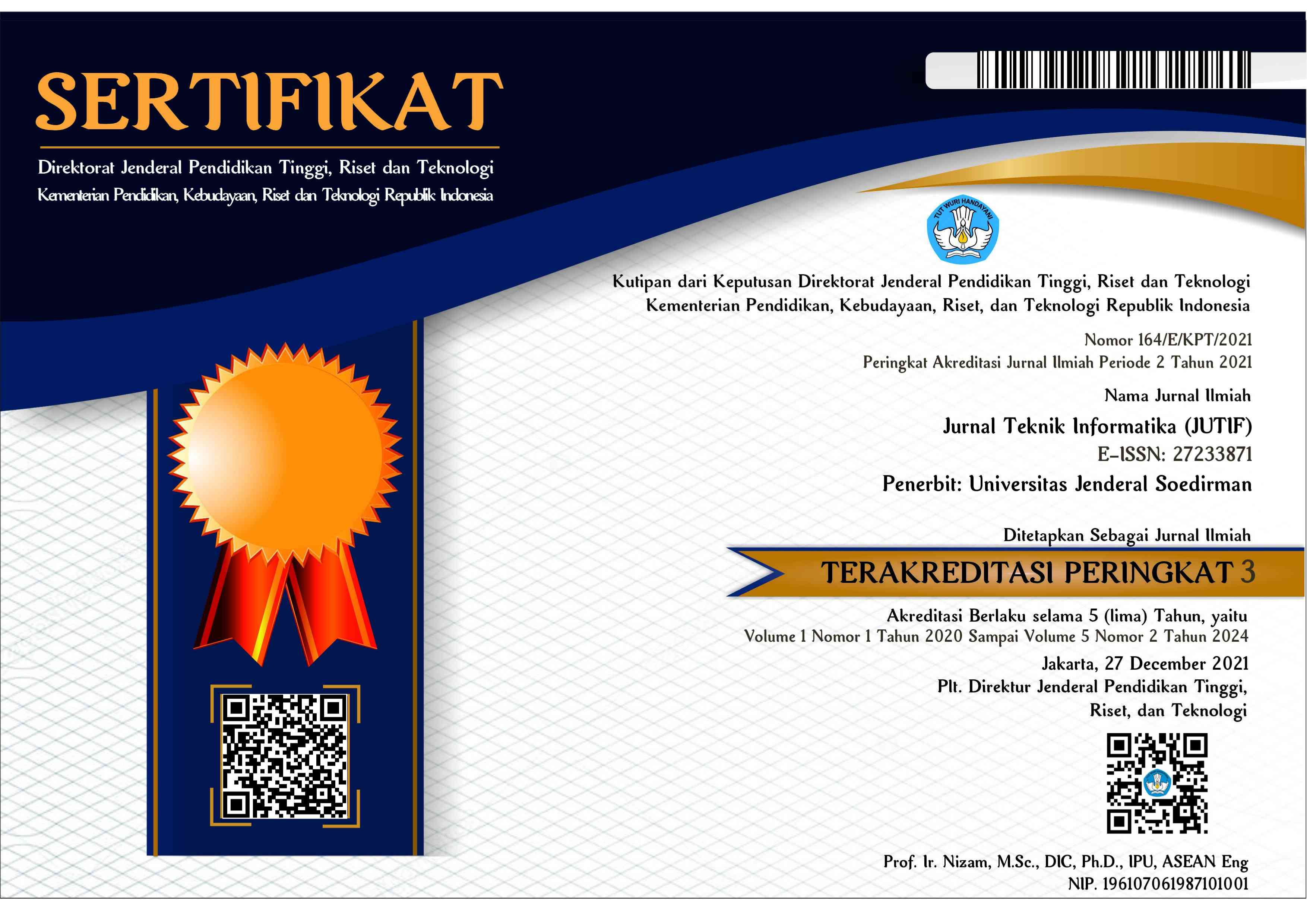CHATBOT FEATURES ON WEBSITES USING DIALOGFLOW FRAMEWORK WITH RULE-BASED METHOD
Abstract
A chatbot is an artificial intelligence (AI) technology that can mimic human conversation in the form of text or voice messages through a website, or mobile application. Chatbots are widely used to facilitate communication, such as finding information, or services. In this research, the difficulty of accessing information in obtaining answers to questions asked by the public, as well as taking too long for the admin to reply when providing information to people who ask questions related to information about the topic raised, is an initial problem that will be solved in this research. Chatbot is a solution that can overcome the above problems, chatbot itself is designed to help food license applicant services on the website of the Semarang City Health Office in the field of Pharmacy and Perbekes. By utilizing the Dialogflow framework, this chatbot will use the Rule-Based method because in this development, the Rule-Based method can adjust common questions and answers that are often asked by the public, and can also be changed and even expanded to manage conversations without experiencing much difficulty in changing them that follow questions that are often asked over time. The system consists of agents, intentions, and training phrases that will be trained to understand various questions and provide relevant responses. This chatbot development aims to improve the efficiency of food licensing services, reduce applicant waiting time, and provide accurate and easily accessible information. The test results in this development are on a chatbot system that can run well, and is able to understand various kinds of questions related to food licensing, and provide appropriate responses in accordance with the predetermined intent. In addition, an evaluation of the level of user satisfaction will be carried out to measure the success of this system. This chatbot can improve the quality of public services in the field of food licensing and provide convenience for the public in processing licenses.
Downloads
References
Saurabh Srivastava, “Desirable Features of a Chatbot-building Platform | IEEE Conference Publication | IEEE Xplore.” Accessed: Jun. 10, 2024. [Online]. Available: https://ieeexplore.ieee.org/document/9230397/
F. Ishlakhuddin and A. Sn, “Ontology-based Chatbot to Support Monitoring of Server Performance and Security By Rule-base,” Indonesian J. Comput. Cybern. Syst., vol. 15, no. 2, p. 131, Apr. 2021, doi: 10.22146/ijccs.58588.
H. S. Putra, H. Santoso, and C. Cifran, “IMPLEMENTATION OF CHATBOT CUSTOMER SERVICE FEATURES ON PT DIAN PRIMA JAYARAYA USING DIALOGFLOW,” Infotech: Journal of Technology Information, vol. 8, no. 2, Art. no. 2, Nov. 2022, doi: 10.37365/jti.v8i2.151.
B. Deshpande and M. B. Chandak, “survey of designing tools for chatbot application,” ijhs, pp. 1403–1413, Jun. 2022, doi: 10.53730/ijhs.v6nS5.8889.
D. Khurana, A. Koli, K. Khatter, and S. Singh, “Natural language processing: state of the art, current trends and challenges,” Multimed Tools Appl, vol. 82, no. 3, pp. 3713–3744, Jan. 2023, doi: 10.1007/s11042-022-13428-4.
M.-H. Chao, A. J. C. Trappey, and C.-T. Wu, “Emerging Technologies of Natural Language‐Enabled Chatbots: A Review and Trend Forecast Using Intelligent Ontology Extraction and Patent Analytics,” Complexity, vol. 2021, no. 1, p. 5511866, Jan. 2021, doi: 10.1155/2021/5511866.
E. Meiliverani and C. Yefta, “Web-Based Chatbot with Natural Language Processing and Knuth-Morris-Pratt (Case Study: Universitas Internasional Batam),” j. sains. teknologi., vol. 11, no. 1, Apr. 2022, [Online]. Available: https://dx.doi.org/10.23887/jst-undiksha.v11i1
M. Soori, B. Arezoo, and R. Dastres, “Artificial intelligence, machine learning and deep learning in advanced robotics, a review,” Cognitive Robotics, vol. 3, pp. 54–70, 2023, doi: 10.1016/j.cogr.2023.04.001.
A. Puspitasari, A. N. Paradhita, Y. W. Tineka, V. Sulistyowati, N. K. S. Noriska, and Haryanto, “Natural Language Processing (NLP) Technology for Chatbot Website,” jppipa, pendidikan ipa, fisika, biologi, kimia, vol. 10, no. SpecialIssue, pp. 319–324, Aug. 2024, doi: 10.29303/jppipa.v10iSpecialIssue.8241.
I. Suryansyah, S. T. Anggraini, L. Prananingrum, and F. A. Fayyadh, “WEBSITE PENGELOLA BOT LINE MESSENGER MENGGUNAKAN PHP MYSQL,” JDTI, vol. 5, no. 1, p. 13, Mar. 2022, doi: 10.32502/digital.v5i1.4135.
D. W. Harahap and L. Fitria, “Aplikasi Chatbot Berbasis Web Menggunakan Metode Dialogflow,” JICOM, vol. 1, no. 1, pp. 6–13, Apr. 2020, doi: 10.33059/j-icom.v1i1.2796.
N. Nasikhah, G. Wijaya, and T. P. Rahayu, “Chatbot for Public Relations and Customer Service in Indonesia: A Diffusion Innovation Study,” Sostek, vol. 21, no. 3, pp. 278–290, Nov. 2022, doi: 10.5614/sostek.itbj.2022.21.3.5.
N. Naus and J. Jeuring, “Building a Generic Feedback System for Rule-Based Problems,” in Trends in Functional Programming, vol. 10447, D. Van Horn and J. Hughes, Eds., in Lecture Notes in Computer Science, vol. 10447. , Cham: Springer International Publishing, 2019, pp. 172–191. doi: 10.1007/978-3-030-14805-8_10.
R. U. Islam, An Improved Belief Rule-Based Expert System with an Enhanced Learning Mechanism. Luleå University of Technology, 2020.
T. Hidayat, PEMBAHASAN STUDI KASUS SEBAGAI BAGIAN METODOLOGI PENELITIAN. 2019.
A. Chandra, D. Kurniawan, and R. Musa, “Perancangan Chatbot Menggunakan Dialogflow Natural Language Processing (Studi Kasus: Sistem Pemesanan pada Coffee Shop),” JURNAL MEDIA INFORMATIKA BUDIDARMA, vol. 4, p. 208, Jan. 2020, doi: 10.30865/mib.v4i1.1505.
T. Aji Prayogo, A. Bagus Setiawan, and D. Wahyu, “View of Pemesanan Tiket Bus Mengunakan Metode Rule Based | Prosiding SEMNAS INOTEK (Seminar Nasional Inovasi Teknologi).” Accessed: Aug. 16, 2024. [Online]. Available: https://proceeding.unpkediri.ac.id/index.php/inotek/article/view/3534/2336
C. F. N. Halizah and M. Kartikasari, “IMPLEMENTASI ALGORITMA NAÏVE BAYES DALAM PENENTUAN PEMBERIAN BEASISWA KIP KULIAH (STUDI KASUS STIKI MALANG),” vol. 12, no. 2, 2024.
T. Makasi, A. Nili, K. Desouza, and M. Tate, “Chatbot-mediated public service delivery,” FM, Nov. 2020, doi: 10.5210/fm.v25i12.10598.
S. P. Barus and E. Surijati, “Chatbot with Dialogflow for FAQ Services in Matana University Library,” ijicom, vol. 3, no. 2, p. 62, Jun. 2022, doi: 10.35842/ijicom.v3i2.43.
A. Henk and F. Nilssen, “Can AI Become a State Servant? A Case Study of an Intelligent Chatbot Implementation in a Scandinavian Public Service,” Jan. 2021, [Online]. Available: https://www.researchgate.net/publication/349153482_Is_AI_ready_to_become_a_state_servant_A_case_study_of_an_intelligent_chatbot_implementation_in_a_Scandinavian_Public_Service
Copyright (c) 2024 Muhammad Afiq Nabiha Riandika, Ajib Susanto, Nabila Maharani Respatria

This work is licensed under a Creative Commons Attribution 4.0 International License.




























